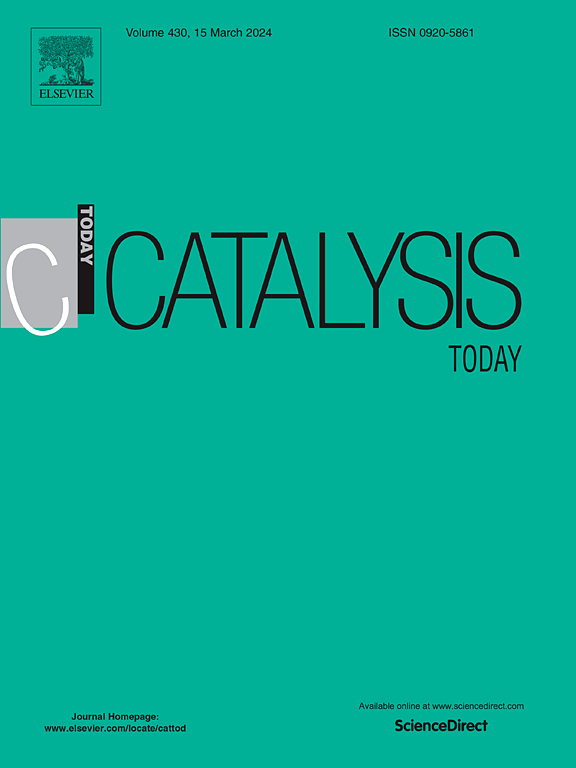IL/MIL-101-NH2 heterogeneous catalyst prepared by acid-base self-assembly for hydrodeoxygenation of 2,5-tetrahydrofurandicarboxylic acid to adipic acid
IF 5.2
2区 化学
Q1 CHEMISTRY, APPLIED
引用次数: 0
Abstract
Bio-based route for preparing adipic acid (AA) from 5-hydroxymethylfurfural is the direction for achieving green and sustainable AA production. In light of the challenges, such as corrosion and difficulties in recycling of I- containing homogeneous catalyst, large amount, high cost, and significant mass transfer resistance of ionic liquid (IL) catalyst, encountered in the current hydrodeoxygenation of 2,5-tetrahydrofurandicarboxylic acid (THFDCA) to AA process. Herein, 1-sulfobutyl-3-methylimidazolium iodide IL ([HSO3-b-mim]·I) was used to functionalize MIL-101-NH2 through acid-base self-assembly approach, hence, a heterogeneous catalyst, IL/MIL-101-NH2 was designed and applied in the hydrodeoxygenation of THFDCA to bio-based AA for the first time. When reacted at 180 °C for 2 h, the THFDCA conversion and AA yield were 100 % and 99.9 %, respectively. Moreover, IL/MIL-101-NH2 exhibited remarkable stability and could be reused multiple times with minimal loss in activity. XRD, SEM, FT-IR, BET, XPS, and TG results revealed that the functionalization process involved the reaction between HSO3 in the IL and NH2 in MIL-101-NH2, forming a salt that chemically bonded the IL to MIL-101-NH2, thereby enhancing stability. The excellent hydrodeoxygenation activity was attributed to the synergistic effect of the Lewis acid site (Cr3+) and the Lewis base nucleophilic site (I-) within IL/MIL-101-NH2.
通过酸碱自组装制备的 IL/MIL-101-NH2 异相催化剂,用于将 2,5-四氢呋喃二甲酸加氢脱氧生成己二酸
从 5-羟甲基糠醛制备己二酸(AA)的生物基路线是实现绿色和可持续己二酸生产的方向。鉴于目前 2,5-四氢呋喃二甲酸(THFDCA)加氢脱氧制备己二酸过程中遇到的挑战,如含 I 的均相催化剂的腐蚀和回收困难、离子液体催化剂用量大、成本高、传质阻力大等。本文利用 1-磺丁基-3-甲基碘化咪唑鎓 IL([HSO3-b-mim]-I)通过酸碱自组装方法对 MIL-101-NH2 进行官能化,从而设计出一种异相催化剂 IL/MIL-101-NH2,并首次应用于 THFDCA 加氢脱氧制备生物基 AA。在 180 °C 下反应 2 小时后,THFDCA 转化率和 AA 产率分别达到 100 % 和 99.9 %。此外,IL/MIL-101-NH2 表现出显著的稳定性,可多次重复使用,且活性损失极小。XRD、SEM、FT-IR、BET、XPS 和 TG 结果表明,官能化过程涉及 IL 中的 HSO3 与 MIL-101-NH2 中的 NH2 反应,形成一种盐,将 IL 与 MIL-101-NH2 化学键合,从而提高了稳定性。优异的氢脱氧活性归功于 IL/MIL-101-NH2 中路易斯酸位点(Cr3+)和路易斯碱亲核位点(I-)的协同效应。
本文章由计算机程序翻译,如有差异,请以英文原文为准。
求助全文
约1分钟内获得全文
求助全文
来源期刊

Catalysis Today
化学-工程:化工
CiteScore
11.50
自引率
3.80%
发文量
573
审稿时长
2.9 months
期刊介绍:
Catalysis Today focuses on the rapid publication of original invited papers devoted to currently important topics in catalysis and related subjects. The journal only publishes special issues (Proposing a Catalysis Today Special Issue), each of which is supervised by Guest Editors who recruit individual papers and oversee the peer review process. Catalysis Today offers researchers in the field of catalysis in-depth overviews of topical issues.
Both fundamental and applied aspects of catalysis are covered. Subjects such as catalysis of immobilized organometallic and biocatalytic systems are welcome. Subjects related to catalysis such as experimental techniques, adsorption, process technology, synthesis, in situ characterization, computational, theoretical modeling, imaging and others are included if there is a clear relationship to catalysis.
 求助内容:
求助内容: 应助结果提醒方式:
应助结果提醒方式:


